
President Donald Trump has recently declared the drug crisis a public health emergency. Trump followed the recommendations of the Commission on Combatting Drug Addiction and the Opioid Crisis to “awaken every American to this simple fact: If this scourge has not found you or your family yet, without bold action by everyone, it soon will.” In 2016, 64,000 Americans died from an overdose. That’s more deaths than during the Vietnam War and both Iraq Wars combined.
Trump is rightly talking about a problem that will take generations to fix because the prescription medication, heroine and fentanyl crisis combines some of the country’s key challenges: a dysfunctional health care system, a one-sided justice system and the population’s low education level. The epidemic is also aggravated by divisions within American society. For a long time, urban America, which prospered, hardly noticed the misery that engulfed rural America. And ideological stubbornness often stifles real help.
Disincentives in the American health care system have caused the crisis and prevent its containment. For a long time, pharmaceutical companies were able to claim that their opioid medication was harmless. They swamped America with oxycodone and hydrocodone pills. Campaign contributions helped the industry keep watchdogs at a distance. It didn’t take much to convince patients after a root canal or lumbago to embrace a feeling of utter bliss that in many other countries is reserved for cancer patients. For American physicians, customer satisfaction is the driving factor for assessing risks and side effects. At the same time, they were pressured by the insurance industry that supplied them with patients: Pills are cheaper than diagnostics, surgery and physiotherapy.
Some doctors turned criminal to become drug dealers. Some doctors in rural America, cut off from any form of professional development, debate or daily newspapers, still believe the myth of the harmless wonder drug. But a majority of physicians are caught in a dilemma. If they continue to prescribe opioids, the cycle will never be broken. In 2015, physicians prescribed enough pills for every American to get high for three weeks straight. But if physicians refuse to prescribe medication to patients who have been numbing their pain and their problems for years, they will drive them into the arms of the drug cartels.
And patients will switch to heroin or the even deadlier fentanyl. Only 1 in 10 addicts is receiving treatment, and even fewer are receiving residential treatment. So-called rehab or detoxification centers in rural areas are often nothing more than shelters where drug deals continue to thrive outside the building. The health care reform debate, which Trump so recklessly inflamed, prevents key players from making a joint effort. When hospital groups, insurance companies and elected representatives fight for trillions of dollars, addiction treatment becomes a tactical commodity.
Demoralized by Globalization
Trump’s return to law and order does not help. Incarceration in crowded jails usually turns addicted, low-level dealers not into productive members of society, but into well-connected criminals. Those who want to be elected sheriff, district attorney or judge will, in large parts of the country, not be able to get there based on a promise to provide convicted criminals with expensive therapy. Although the crisis is everywhere, empathy for the victims grows very slowly among the general population. Many Americans consider drug use a bad decision, not a disease, and it should not be rewarded by helping addicts return to a normal life.
Should taxpayers or those who pay health insurance premiums finance the resources that help addicts breathe again after an overdose? Should local authorities hand out clean syringes to at least slow down the spread of AIDS? Should addicts receive so-called drug substitutions? Most experts answer these questions with a “yes.” Many conservatives instinctively say “no,” and in some parts of the country they even prevent schools from educating students about the dangers of drugs. These battles, fought on a daily basis in municipal councils and on local internet forums, also play out in Washington. Fiscal conservatives who generously approved billions of dollars for relief efforts for hurricane victims in Texas and Florida become stingy when it comes to helping drug addicts.
The life expectancy of white Americans is sinking due to opioid dependency. In some parts of the country where Trump won hands down, local politicians want to settle as many refugees as possible, because in contrast to Trump’s “forgotten men and women,” Syrian and Burmese job seekers usually pass mandatory drug tests.
Globalization and automation have left parts of the U.S. deserted and many people demoralized. Politicians of both parties talked them into believing that their hard work would soon pay off again. With the help of drugs, many Americans are also avoiding the realizationt that this is not as easily done in the 21st century as it was 50 years ago. To tackle its drug problem, America will have to face the truth first.

Leave a Reply
You must be logged in to post a comment.